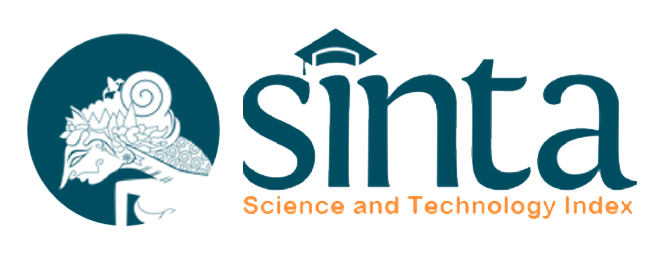Coffee Area (Subak Abian Tri Guna Karya Kintamani Bangli) Based Waste Management Potential to Generate Renewable Energy Sources and Nutrition
Abstract
Bali island has 5.632.86 km2 area with a total area of 36.298 hectares of coffee farm in 2004with production 3.696.206 15386.405 tons of Arabica coffee and Robusta coffee produces tonsof waste is high enough. The results of the proximate analysis of robusta coffee waste containingprotein, crude fiber and fat is high at 6.67 to 12.43% crude protein, fiber kasar11,05-21,40%, fat1.04 to 1.07%, while the calcium 0 , 21 to 0.34% and 0.02-0.07% phosfor.Materials (coffee waste) inserted through the container revenue in accordance with thetreatment, then allowed to ferment anaerobically for 35 days, if the bio-gas already formed inlarge volume, then the bio-gas flow from the inner tube to cleaners tube which then exits througha gas hose. Bio-gas has started to form when the water in the U manometer and hose materialspointer moves upward.Parameters measured were the temperature of the fermentation medium was measured with athermometer scale 0-100oC. Volume of bio-gas can be shown on the hose raw material pointerwas the changes of the surface of raw material height multiplied by its width. Gasbio pressureinside the bioreactor was measured using a manometer U scaleD 3-3 cm. gasbio production wasmeasured by thermik properties of the gas or through the ideal gas equation (Sutanto, 1982).Technical analysis measured through the strength of materials, dimensions and weight. Thecontent of gasbio is observed from methanogenic process is methane gas, and of the hydrolysisand acidification processes was carbon dioxide gas using a Shimadzu GC-7A kromatograf modelChemical analysis of coffee waste and bio-gas as byproduct was crude fiber, nitrogen, fattyacids, calcium, phosphorus, iron, magnesium, manganese, potassium, sodium and zinc as well ascaffeine using atomic spetrophotometes.Handling of coffee waste using region-based bioreactors (Subak Abian Tri to workKintamani Bangli) generate renewable energy, a source of nutrients and bioactive and spawned aculture of energy saving, clean and healthyDownloads
Download data is not yet available.
References
Anwar A., Rumana G., dan Zularisam
A.W, 2011. Bioenergy from anaerobic
degradation of lipids in palm oil mill
effluent, Review Environment Science
Biotechnology, p. 353–376.
Areas of Asia A Status Report,
1981.Improving soil Fertitility through
Organic Recycling, FAO/ UNDP
Regional Project RAS/75/004,Project
Field Document No. 10.
Gunnerson.C.G and Stuckev. D.C. 1986.
Anaerobic diqestion: Preinceples and
practices for biogas system.The work
and Washington. D.C., USA.
Jagani et al, 2010. An Overview of
Fermenter and the Design
Considerations to Enhance Its
Productivity, Pharmacologyonline. p.
261-301.
Kementerian Lingkungan Hidup Republik
Indonesia, 1995. Keputusan Menteri
Lingkungan Hidup Nomor: KEP
51/MEN KLH/10/1995 Tentang: Baku Mutu Limbah Cair bagi Kegiatan
Industri.
Price, E. C and Cheremisinoff, P. N. 1982.
Biogas production and utilization.
Michigan: Ann Arbor Science
Publishers, Inc.
Romli, M, Suprihatin dan Dinna,S, 2010.
Penentuan Nilai Parameter Kinetika
Lumpur Aktif untuk Pengolahan Air
Lindi Sampah (Leachate), Jur.Tek. Ind.
Pert. p. 55-26.
Suhut Simamora, Salundik, Sri Wahyuni,
& Surajudin, 2006. Membuat Bio Gas
Pengganti Bahan Bakar Minyak & Gas
dari Kotoran Ternak AgroMedia
Pustaka, Jakarta. http ://www. i-sis
org.uk/Biogas China.php.
Taguchi, Genichi. 2005. Taguchi’s quality
engginering handbook. New Jersey:
Hoboken.
TeguhWikanWidodo, Ana N., A.Asari dan
Elita R. 2011. Pemanfaatan Limbah
Industri Pertanian Untuk Energi
Biogas, Balai Besar Pengembangan
Mekanisasi Pertanian Serpong Badan
Litbang Pertanian, Departemen
Pertanian.
Tong, S.L., & A.B. Jaafar, 2005. POME
Biogas Capture, Upgrading, and
Utilization. Proceedings of the PIPOC
2005 International Palm Oil Congress
(Chemistry and Technology), p. 328-
336.
Walas, Stanley M. 1988. Chemical
process equipment, Butterworth-
Heinemann, Wash-ington.
Wikipedia.
2010.http://en.wikepedia.org/wiki/Coff
ee_watewater (diakses Mei 1, 2011).
Zuhrina, 2004. Model Matematik Gas
Hold Up di dalam Tangki
Berpengaduk, USU digital Library,
Medan.
A.W, 2011. Bioenergy from anaerobic
degradation of lipids in palm oil mill
effluent, Review Environment Science
Biotechnology, p. 353–376.
Areas of Asia A Status Report,
1981.Improving soil Fertitility through
Organic Recycling, FAO/ UNDP
Regional Project RAS/75/004,Project
Field Document No. 10.
Gunnerson.C.G and Stuckev. D.C. 1986.
Anaerobic diqestion: Preinceples and
practices for biogas system.The work
and Washington. D.C., USA.
Jagani et al, 2010. An Overview of
Fermenter and the Design
Considerations to Enhance Its
Productivity, Pharmacologyonline. p.
261-301.
Kementerian Lingkungan Hidup Republik
Indonesia, 1995. Keputusan Menteri
Lingkungan Hidup Nomor: KEP
51/MEN KLH/10/1995 Tentang: Baku Mutu Limbah Cair bagi Kegiatan
Industri.
Price, E. C and Cheremisinoff, P. N. 1982.
Biogas production and utilization.
Michigan: Ann Arbor Science
Publishers, Inc.
Romli, M, Suprihatin dan Dinna,S, 2010.
Penentuan Nilai Parameter Kinetika
Lumpur Aktif untuk Pengolahan Air
Lindi Sampah (Leachate), Jur.Tek. Ind.
Pert. p. 55-26.
Suhut Simamora, Salundik, Sri Wahyuni,
& Surajudin, 2006. Membuat Bio Gas
Pengganti Bahan Bakar Minyak & Gas
dari Kotoran Ternak AgroMedia
Pustaka, Jakarta. http ://www. i-sis
org.uk/Biogas China.php.
Taguchi, Genichi. 2005. Taguchi’s quality
engginering handbook. New Jersey:
Hoboken.
TeguhWikanWidodo, Ana N., A.Asari dan
Elita R. 2011. Pemanfaatan Limbah
Industri Pertanian Untuk Energi
Biogas, Balai Besar Pengembangan
Mekanisasi Pertanian Serpong Badan
Litbang Pertanian, Departemen
Pertanian.
Tong, S.L., & A.B. Jaafar, 2005. POME
Biogas Capture, Upgrading, and
Utilization. Proceedings of the PIPOC
2005 International Palm Oil Congress
(Chemistry and Technology), p. 328-
336.
Walas, Stanley M. 1988. Chemical
process equipment, Butterworth-
Heinemann, Wash-ington.
Wikipedia.
2010.http://en.wikepedia.org/wiki/Coff
ee_watewater (diakses Mei 1, 2011).
Zuhrina, 2004. Model Matematik Gas
Hold Up di dalam Tangki
Berpengaduk, USU digital Library,
Medan.
Published
2015-09-30
How to Cite
SUCIPTA, INyoman.
Coffee Area (Subak Abian Tri Guna Karya Kintamani Bangli) Based Waste Management Potential to Generate Renewable Energy Sources and Nutrition.
Media Ilmiah Teknologi Pangan (Scientific Journal of Food Technology), [S.l.], v. 2, n. 2, p. 141–147, sep. 2015.
ISSN 2477-2739.
Available at: <https://ojs.unud.ac.id/index.php/pangan/article/view/18732>. Date accessed: 04 nov. 2025.
Issue
Section
Articles
Keywords
Waste management; energy sources; nutrition







